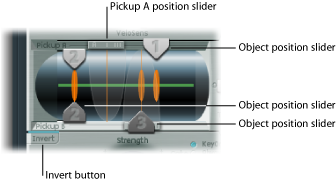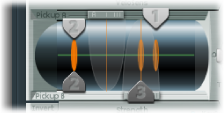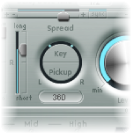Working with Sculpture’s Pickups
The pickup parameters discussed in this section apply on a per-voice basis. You will note a number of parameter names followed by (morphable). This indicates that the parameters can be morphed between up to five morph points. For more details, see Getting to Know Sculpture’s Morph Section.
The pickups are the first element beyond the sound generating portion of Sculpture—consisting of the string and objects—and act as the input to the virtual signal processing chain. You can view the pickups as being like those of an electric guitar or clavinet. Obviously, changing their positions will alter the tone of your instrument, and they’ll do the same in Sculpture.

- Object position sliders (morphable): Sliders 1, 2, and 3 determine the respective position of each (excite/disturb/damp) object along the string. See Changing Object Positions in Sculpture’s Pickup Display.
- Pickup A position slider (morphable): Determines the position of Pickup A along the string. Values of 0.0 and 1.0 determine the left and right ends of the string, respectively.
- Pickup B position slider (morphable): Determines the position of Pickup B along the string, shown underneath Object position slider 3 at the bottom of the image.
- Invert button (Pickup B Phase): Inverts the phase of Pickup B. Found at the lower left of the Pickup display. Options are: normal or invert(ed).
Note: If the phase of Pickup B is inverted, the sound can become thinner due to portions of the Pickup A and Pickup B signals canceling each other out. Depending on the position of the pickups, however, the reverse may happen, with the sound actually becoming richer.
Drag the slider handle at the top or bottom of the Pickup display.
The Pickup A and B ranges are shown as transparent bell curves, which represent the position and widths of pickups A and B.
The green horizontal line within the pickup display represents the string. As the Stiffness parameter value of the string is increased, the line becomes thicker. The line can be animated and will show the range of the string’s motion.
Control-click the green horizontal line—the string—to activate or deactivate animation.
When active, the string vibrates, making it easier to visualize the impact of the objects and pickups. Note that string animation increases CPU overhead, so disable it if your computer is struggling to process all data in real time.
Changing Object Positions in Sculpture’s Pickup Display
Adjustments to object positions will disturb/excite a given portion of the string. The vertical orange lines represent the positions of Objects 1, 2, and 3. The thickness and brightness of these lines indicate the strength of the objects. Object 1 can be an exciter. Object 3 can be a damper. Object 2 has two arrows, indicating that it can be used as either an exciter or damper.

Drag the corresponding numerical slider handle (the 1, 2, or 3 arrows) for each object.
Note: As you move the object pickups through the Pickup A and B ranges, the intensity of the object disturbance increases significantly. This gives rise to a number of changes that can completely alter the general timbre of your sound.
Using Sculpture’s Spread/Key Controls
Although they are not found in the actual Pickup display, two further pickup parameters are available to the right of the Material Pad.

- Key Spread: Sets the amount of panning (pan position) by MIDI note number. Depending on settings, the further up or down the keyboard you play, the more the voice is panned left or right. Drag vertically on the Key button to adjust. Two lines in the ring that surrounds the Spread parameters indicate values.
- Pickup Spread: Spreads the two pickups across the stereo base. In other words, the pickup position, combined with this parameter, will be spread further toward/from the left/right stereo channels. Drag the Pickup button vertically to adjust. Two dots in the ring that surrounds the Spread parameters indicate the values.
Note: You can create animated width and chorus effects by modulating the Pickup Position parameters with an LFO or other modulator.